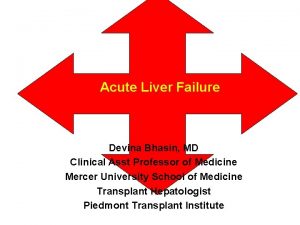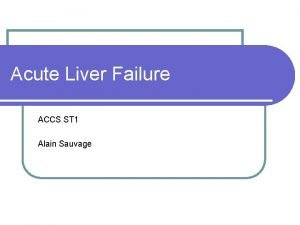Outcomes of acute cardiac failure after cardiac surgery

- Slides: 1

Outcomes of acute cardiac failure after cardiac surgery 24339 K. Rutka 1, 2, R. Leibuss 1, 2, B. Arkliņa 1, 2, V. Harlamovs 2, P. Stradiņš 1, 2, E. Strīķe 1, 2 Riga Stradins University 2 Pauls Stradins Clinical University Hospital 1 Acute cardiac failure following cardiac surgery is associated with an increase in mortality. Treatment with inotropes, including calcium sensitizers (CS), inhaled nitric oxide (i. NO), veno-arterial extracorporeal membrane oxygenation (VA-ECMO) are therapeutic cornerstones of this post-operative complication. However, data regarding calcium sensitizer effect on mortality remain controversial. Objective To review outcomes of patients treated with a calcium sensitizer for acute cardiac failure after undergoing cardiac surgery at Pauls Stradins Clinical University Hospital (PSKUS) in 2018. In 2018, a total of 1263 patients underwent cardiac surgery on cardiopulmonary bypass (CPB), 59 of them received CS for acute cardiac failure after cardiac surgery. Median age of patients receiving CS was 68± 18 years, and median preoperative left ventricular ejection fraction (LVEF) was 45± 26%. See other patient characteristics in Table 1. Overall mortality of patients after CPB surgery in 2018 was 2. 8% (35 out of 1263), but among patients receiving CS – 44. 1% (n=26). The mortality of patients who received CS together with VA-ECMO and i. NO was 100%. For patients with preoperative LVEF <35% the cumulative 90 -day survival was 60. 0%, but among patients with preoperative LVEF ≥ 35% – 50. 7% (p=0. 610). We performed a retrospective review of patient medical records and the local registry of outcomes and treatments maintained at the PSKUS Department of Cardiac Anaesthesia and Intensive Care. All patients treated with a CS for acute cardiac failure following cardiac surgery in 2018 were included in the study. 60. 0% Patient characteristics n Median age, years ± IQR Female gender, % Median preoperative LVEF, % ± IQR Elective surgery, % 59 45. 8 45± 26 57. 6 CABG, n 11 Valve surgery, n 18 Combined surgery, n 18 Other cardiac surgery, n 12 CS, n (%) CS+i. NO, n (%) CS+ECMO+i. NO, n (%) 50. 7% 68± 18 42 (71. 2%) 1 (1. 7%) 12 (20. 3%) Image 1. Cumulative survival curves of patients with preoperative LVEF <35% (blue line) and preoperative LVEF ≥ 35% (green line). 4 (6. 8%) Table 1. Characteristics of patients included in the study. IQR – interquartile range; LVEF – left ventricular ejection fraction; CABG – coronary artery bypass graft. • • • Image 1. Patient with acute cardiac failure after cardiac surgery at PSKUS Department of Cardiac Anaesthesia and Intensive Care. Patients with acute cardiac failure after cardiac surgery treated with CS represent a high-risk patient group with a notably higher mortality than the overall cardiac surgery patient population. The difference in cumulative survival of patients with preoperative LVEF <35% and LVEF ≥ 35% did not reach statistical significance, not showing a survival benefit of CS use in patients with very low preoperative LVEF. Patients in our study did not benefit from combined acute cardiac failure treatment with CS, VA-ECMO un i. NO, as shown by the 100% mortality in this patient group, perhaps reflecting the overall severity of the patient condition. Further studies are required, investigating factors potentially affecting CS beneficial effects, e. g. , administration timing (pre-, intra-, post-operative) and mode (with or without bolus dose). Outcome studies for expensive therapies, such as calcium sensitizers, ECMO, i. NO, are necessary in order to make more cost-effective clinical decisions and improve therapeutic results.

